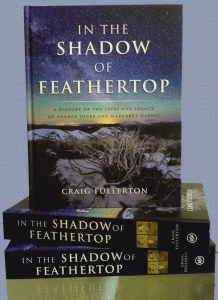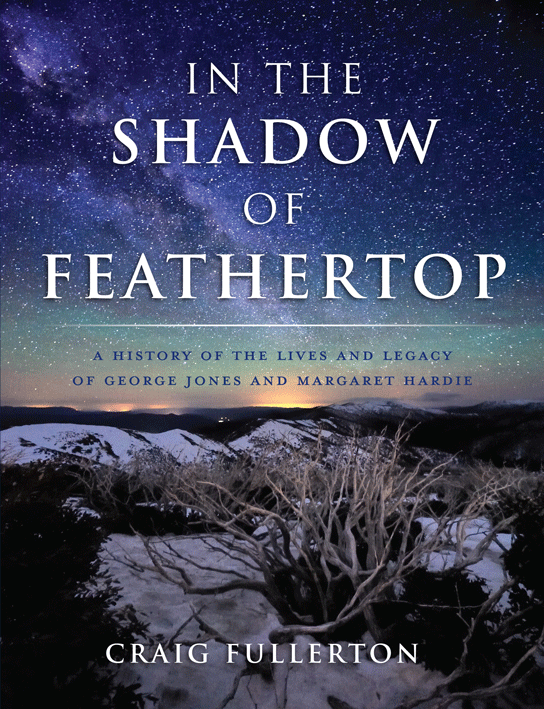Boat Shore Publishing. ISBN: 978-0-646-92155-6
BUY IT ONLINE NOW
Prefer not to buy online? No problem! Simply email Craig to organise your book(s)!
________________________________________________________________________________________
WINNER of the ALEXANDER HENDERSON AWARD 2014 for BEST AUSTRALIAN FAMILY HISTORY awarded by the Australian Institute of Genealogical Studies.
![]() This is a most impressive book, lavishly and beautifully produced and illustrated, thoroughly researched, with detailed references and sources given. It tells the story of the Jones family and their migration from Cockenzie in Scotland to Harrietville in northeast Victoria in the 19th century, and the legacy they left to descendants. It contains a comprehensive index and bibliography and extensive genealogical charts. The judges felt it was a very worthy winner of the Alexander Henderson Award
This is a most impressive book, lavishly and beautifully produced and illustrated, thoroughly researched, with detailed references and sources given. It tells the story of the Jones family and their migration from Cockenzie in Scotland to Harrietville in northeast Victoria in the 19th century, and the legacy they left to descendants. It contains a comprehensive index and bibliography and extensive genealogical charts. The judges felt it was a very worthy winner of the Alexander Henderson Award ![]() AIGS Judging Panel
AIGS Judging Panel
________________________________________________________________________________________
This beautiful hardcover book of 646 pages in a coffee table book format tells the story of George Jones and his wife Margaret (nee Hardie), the first of this branch of the author’s family to come to Australia. The book contains over 400 photographs, maps and illustrations, including an 8 page colour map section, endnotes, bibliography, a name index and a general index.
George Jones was a native of Cockenzie, a small fishing village on the Firth of Forth, just to the east of Edinburgh in Scotland. He was a grandson of John Jones and Agnes Young who first started raising their family there in 1774. Another of John and Agnes’ descendants — their 5th Great-granddaughter — is Mary, nee Donaldson, the present-day Crown Princess of Denmark. Her son, Prince Christian — the 6th Great-grandson of John and Agnes Jones — may one day be crowned King of Denmark.
Margaret Hardie was born in Newarthill, a small mining village in Lanarkshire to the south of Glasgow, where her father, Peter, worked as a mine manager. Peter, and his wife Elizabeth Cowan had their origins in Airth in Stirlinghshire.
George and Margaret married in Newarthill in 1847 and had five children in the ensuing years. In late 1857 George made the long journey to Australia to seek his fortune during the gold rush which was then transforming Australian society. He arrived in February 1858. It would be almost six years before Margaret and the children came out to join him. After an epic journey taking five months across the sea, by dray, and on foot, Margaret and the children were finally reunited with George in 1863 on a dirt track just near Harrietville, a small gold mining settlement nestled at the foot of Mt. Feathertop in Victoria. They would spend the rest of their lives living in the shadow of Feathertop at Harrietville, bearing another four Australian-born children. They were true pioneers.
Who were these people? What motivated them to uproot their families and leave Scotland, the land where their forebears had lived since time immemorial? What was their new life like in Australia, and how did they fare?
In the Shadow of Feathertop answers these questions. It is in five parts.
Part One traces the origins of this Jones family in Scotland. It examines George and Margaret’s genealogical heritage, which can be traced back to the early 1700s. It also tells the story of George’s birthplace, Cockenzie, and what his upbringing and early life might have been like there. This section covers the period up until the time George married Margaret Hardie in 1847.
Part Two tells the story of George and Margaret Jones from the time of their marriage in Newarthill, Scotland, their early married lives, their separate emigrations to Australia, and what became of them in their new homeland. Their story is inextricably interwoven with the story of the founding and development of the township of Harrietville, They lived in Harrietville from its very earliest days, and spent their entire lives there after arriving in Australia. They were true pioneers.
Part Three deals with each of George and Margaret’s nine children. Five of them were born in Scotland, and four in Australia. What became of them? Who did they marry, and how did their spouses’ families come to be in Australia? The stories of the families who married into the Jones family are also told. Their origins, and their respective journeys to the Ovens Valley, present some fascinating stories that illustrate how the fabric of Victoria’s working-class society was formed in the earliest years of the colony’s existence. Many came to Australia in search of gold like the Jones family, one family came from generations of Cornish copper miners to work in a huge copper mine in South Australia, another came from Canada where his family had settled after fighting for the British in the American War of Independence, and yet another had no choice in the matter having been sent to Australia as a convict from England. Family names include: Cadzow, Tobias, Croucher, Beasley, Hynd, Crossley, Cartledge, Hocking, Lawrence, Buckley, Wall and Scott.
Part Four details all of the known descendants of George and Margaret Jones. It contains over 2,300 names. This part of the book is presented in a format that will be familiar to genealogists, but easy to follow for those who are not. It attempts to list all known descendants with key information such as birth, death and marriage places and dates. For many people beyond George and Margaret and their own children, there is a story to be told and it can be found in this section. Many of them served their new country in WW1 and WW2 and their stories are told. Some of them never made it home and their stories make for harrowing reading.
The Appendices provide additional information and some wonderful side-stories which would have been a distraction in the main sections of the book:
- It covers the Jones family (John Jones, the son of George’s cousin) who settled in Goolwa and Murray Bridge on the Murray River in South Australia along with many other Cockenzie expatriates, one of whom – Francis Cadell – is credited with opening up the mighty Murray to trade with his pioneering steamboats.
- Another wonderful story concerns an old salt, Captain Robert Jones (George’s cousin), who was a part of the famed US Navy Greely Relief Expedition sent to rescue Arctic explorer Lt. Adolphus Greely and his party who had become stranded in the icy wilderness for months with inadequate supplies…
- A wonderful first-hand account of the opening of the Sydney Harbour Bridge written by one of George and Margaret’s grand-daughters is transcribed in the Appendices too.
- Finally this section contains reproductions and transcriptions of a wonderful series of letters sent by William and Euphemia Cadzow to Euphemia’s family in Whitburn, Scotland, and many sent by her family back to them. The first of these letters was written when William and Euphemia were on board their ship waiting to depart England. Others were written from Melbourne soon after their arrival there, and then from the Forest Creek goldfields where they went in search of riches. These letters provide a first-hand account of life on the Victorian goldfields, and the ones from Scotland recount the daily lives of her family in Whitburn, West Lothian. They provide a fascinating glimpse into the daily lives of our ancestors in these times. William and Euphemia’s daughter, Elizabeth Forsyth Cadzow, was born on the Forest Creek goldfields and married George and Margaret’s son, William Jones.
 BUY IT ONLINE NOW
BUY IT ONLINE NOW
Prefer not to buy online? No problem! Simply email Craig to organise your book(s)!
Review the Table of Contents here
View a list of all the names in the book here


